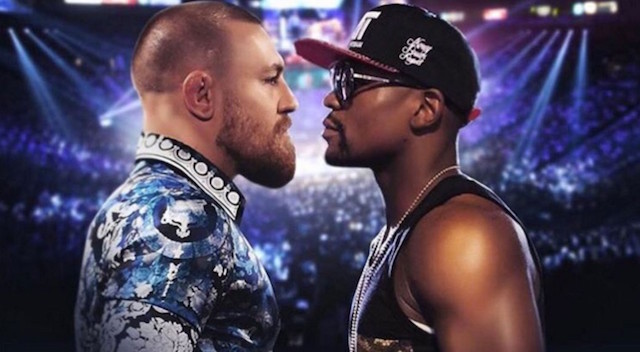Column: McGregor vs Mayweather, a freak show with precedent

Conor McGregor teases fans as he posts a photoshopped poster of him and Floyd Mayweather Jr. on his Twitter account. Photo taken from Conor McGregor’s Twitter account
The freak show that Floyd Mayweather Jr. and Conor McGregor are talking about will almost surely never happen, and for that anyone who would even consider opening their wallet to pay for it should be grateful.
It’s strictly fodder for online babble, no matter how much either man tries to convince people otherwise.
Both seem desperate for attention in floating the idea of a match between a boxer and an MMA fighter. Both are also quite skilled in manipulating social media, as evidenced in the mini-firestorm that erupted online when the idea was broached.
READ: Mayweather says McGregor fight ‘possible’ | White: McGregor-Mayweather ‘impossible’ to happen
But don’t worry about having to save up the $79.95 to buy it on pay-per-view at home. For any number of different reasons, it is about as likely to happen as Rhonda Rousey fighting Mayweather, an idea that got some traction among babblers everywhere last year.
As freak shows go, however, there is some precedent.
It was 40 years ago and Muhammad Ali was the heavyweight champion, still riding the high of beating George Foreman in the Rumble in the Jungle. In search of a good payday, he agreed to go on another trip overseas — to Japan to fight professional wrestler Antonio Inoki in a 15-round match.
Bob Arum was the promoter and wanted to make sure nothing stood in the way of Ali’s upcoming third fight with Ken Norton. He went to wrestling promoter Vince McMahon to figure out a way to protect Ali in the ring in a promotion that would be shown on closed circuit around the United States.
“He came up with a script that was brilliant,” Arum recalled. “Ali liked it; we all liked it.”
The plan was for Ali to catch Inoki on the ropes and pound away with punches that didn’t really land. Inoki was to have hidden a razor in his mouth and cut himself so there was real blood flowing onto Ali’s white trunks.
Ali was supposed to beg the referee to stop the fight, turning his back on Inoki to make his case. At that point, Inoki would jump on Ali’s back, take him down and pin him for the win.
“It’s Pearl Harbor all over again!” Ali was going to yell.
The only problem was Inoki had some handlers who thought it was going to be a real fight. For three days the two sides argued in Arum’s Tokyo hotel suite about the rules for the fight, agreeing on nothing.
When the opening bell rang, Inoki raced across the ring and threw a kick at Ali, falling to the canvas. He stayed there in a crablike position most of the 15 rounds kicking at Ali’s legs.
The greatest heavyweight ever barely landed a punch, not that it mattered. Inoki was already on the ground, so going for a knockout didn’t make much sense.
“Ali kept saying ‘Come on, fight like a man,'” recalled Gene Kilroy, who was Ali’s business manager. “But he kept his cool and didn’t try to dive in on him which was a good thing because Inoki would have knotted him up like a pretzel.”
While Inoki wasn’t in on the plan, the referee was. He declared the fight a draw, much to the displeasure of the crowd in Tokyo.
“It was the low point of my career,” Arum said. “It was so embarrassing, just a total farce.”
Ali wasn’t the only boxer having trouble that night with a wrestler. As part of the promotion, Chuck Wepner met Andre the Giant in New York, drawing more than 30,000 people to Shea Stadium, where they also watched the Ali-Inoki match on big television screens.
Unlike the match in Tokyo, the Bayonne Bleeder and Andre the Giant followed their script.
“When do you want me to throw him out of the ring?” the Giant asked his handlers before the fight.
That’s exactly what happened in the third round when he picked Wepner up like he was a child and tossed him over the ropes in the general direction of second base. As he flew out of the ring, Wepner’s leg caught on the ring rope and he bounced off the ring apron into the crowd.
It was, one wag suggested afterward, one of the best throws to second made all year at Shea.